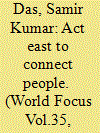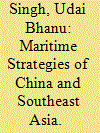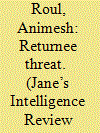|
|
|
Sort Order |
|
|
|
Items / Page
|
|
|
|
|
|
|
| Srl | Item |
| 1 |
ID:
136791


|
|
|
|
|
| Summary/Abstract |
As India marched into the new millennium with her renewed emphasis on what had come to be known as her 'Look East policy' being followed since the early 1990s, the Northeast appears to have been poised for a great leap forward. The region - being the key strategic node through which India can Look East farther towards the countries of Southeast Asia and eventually of East Asia - is no longer considered as 'a cul-de-sac leading nowhere', but as Verghese puts it, “a gateway to lands and opportunities beyond”.
|
|
|
|
|
|
|
|
|
|
|
|
|
|
|
|
| 2 |
ID:
135947


|
|
|
|
|
| Summary/Abstract |
The energy sector is an integral part of the ASEAN Economic Community (AEC). The AEC aims to transform ASEAN into a stable, secure, prosperous, rules-based, competitive, resilient, and integrated economic community by 2015.[①] The ASEAN Vision 2020[②] envisions a clean and green ASEAN with fully established mechanisms for sustainable development to ensure the protection of the environment, the sustainability of its natural resources, and a high quality of life for its people. Such a vision was incarnated at the Bali Summit in October 2003 as the AEC by 2020.[③] The adoption of the AEC Blueprint by the ASEAN Heads of State/Government in November 2007 expedited the implementation of the AEC to 2015.Energy is closely related to three of the four pillar under the AEC: energy commodities are products that will be freely moved in the “single market and production base” (pillar 1); a competitive energy sector is an indispensable part of “the competitive ASEAN” (pillar 2); and access to electricity is a key towards “equitable economic development” (pillar 3).[④]
|
|
|
|
|
|
|
|
|
|
|
|
|
|
|
|
| 3 |
ID:
136664


|
|
|
|
|
| Summary/Abstract |
This article examines how the Association of Southeast Asian Nations (ASEAN) conflict management process in the South China Sea (SCS) has been conducted and whether the ASEAN way can effectively manage the dispute, in which China is a prime and important actor. It argues that rising tensions in the South China Sea are a direct result of the changed balance of power in the region given the asymmetry between China and ASEAN members. China has taken advantage of ASEAN efforts to develop a code of conduct that is premised on the ASEAN way.
Introduction
|
|
|
|
|
|
|
|
|
|
|
|
|
|
|
|
| 4 |
ID:
135317


|
|
|
|
|
| Summary/Abstract |
This paper evaluates the debate over whether China’s emergence as an economic superpower has been a complement or threat to ASEAN by examining data in the eleven years following China’s accession to the WTO. Employing a qualitative approach, it seeks to understand whether China’s growing dominance has hindered ASEAN GDP growth, exports and attractiveness as a destination for FDI. The evidence suggests that China’s rise has caused a shift in global trade patterns, with China dominating Western markets at the expense of ASEAN countries. Despite this, China’s dominance does not appear to have had a significant negative effect on growth rates for ASEAN GDP, exports, or FDI stocks. Given this, the paper concludes that while China is crowding ASEAN out of Western markets, increased Chinese demand for ASEAN imports has more than offset this effect. The result is that ASEAN exports and GDP have grown despite shifting trade patterns in the short run.
|
|
|
|
|
|
|
|
|
|
|
|
|
|
|
|
| 5 |
ID:
134760


|
|
|
|
|
| Summary/Abstract |
The implementation of a free trade area between China and ASEAN has enhanced economic links between them. In spite of this, China’s Southeast Asian neighbours still have strong strategic misgivings about the country’s growth in wealth and power. China’s energy rise, in the form of surging demands and an expanding presence, has added a new ingredient in Sino-Southeast Asian relations. From the combined perspectives of both economic mercantilism and economic liberalism, this article analyses the implications of China’s energy rise on its Southeast Asian neighbours, and the doubts and debates that surround them. Such impacts arguably are mixed, and the more important aspect of such impacts arises not from China’s surging demand per se, but rather from the policies it created to deal with it.
|
|
|
|
|
|
|
|
|
|
|
|
|
|
|
|
| 6 |
ID:
134767


|
|
|
|
|
| Summary/Abstract |
As a research institute based in Singapore, the EAI monitors developments in relations and interactions between China and the individual countries of Southeast Asia as well as the ASEAN grouping as a whole. This material is presented in the form of (1) a chronology of events and (2) important documents.
|
|
|
|
|
|
|
|
|
|
|
|
|
|
|
|
| 7 |
ID:
136667


|
|
|
|
|
| Summary/Abstract |
After the transition period, the Yudhoyono administration seems to be more confident to craft incorporate human right factor in to foreign policy consideration. Indonesia, under his leadership, has been very much interested to developed the Indonesia’s soft power diplomacy through the effort to promote democracy and human rights values both regionally and globally. In the beginning of his administration, the ministry of foreign affairs has pursued for promotion and protection of human rights as new principle to be observed by ASEAN member states, and later as one of important pillar in developing ASEAN political security community.
|
|
|
|
|
|
|
|
|
|
|
|
|
|
|
|
| 8 |
ID:
136621


|
|
|
|
|
| Summary/Abstract |
Cambodia and Myanmar are both identified as “pro-China” Indochinese countries with regimes that rely on political support and economic investment from Beijing. Cambodia and Myanmar, therefore, have become testing grounds for China’s new soft power initiative of “spreading cultural understanding” by means of the establishment of Confucius Institutes. China’s relations with both Cambodia and Myanmar are improving, but local responses to the Confucius Institute initiative differ in the two countries. Phnom Penh has one Confucius Institute and three Confucius Classrooms equipped with thirteen Chinese language teaching stations, including those installed in the Royal Cambodian Armed Forces Academy and the Office of the Prime Minister. The initiative is enthusiastically championed by government and political leaders. In the case of Myanmar, three Confucius Classrooms, rather than Confucius Institutes, have been established by ethnic Chinese associations in Yangon and Mandalay. Lacking governmental endorsement, these Confucius Classrooms need to keep a low profile. The aim of this article is to differentiate between the politics of dependency in China-Cambodia and China-Myanmar relations by exploring local contexts and responses to Beijing’s soft power initiatives.
|
|
|
|
|
|
|
|
|
|
|
|
|
|
|
|
| 9 |
ID:
136124


|
|
|
|
|
| Summary/Abstract |
The possibilities of club monetary interaction mechanisms are very modest as they do not replace but supplement global mechanisms. Nevertheless, they deserve attention and support. Equally important is the fact that such mechanisms may have side effects, namely, general shifts in the structure of global economic governance.
|
|
|
|
|
|
|
|
|
|
|
|
|
|
|
|
| 10 |
ID:
136169


|
|
|
|
|
| Summary/Abstract |
A fundamental challenge in teaching international relations is the need to bridge the students' learning gap between knowledge and practice, providing them with opportunities to reflect on what they have learned and allowing them to develop a greater cognition of their own abilities in the area. The South China Sea is one of the most long-running and complex disputes in contemporary international affairs. It remains one of the few flashpoints around the globe that holds the potential to directly escalate into a great-power conflict. Understanding this issue is therefore an important task for students of IR and strategic studies, but the complexity of the dispute makes teaching it in a regular seminar/lecture format problematic. This article describes a simulation run in a masters-level class in the spring 2012 semester designed to address this pedagogical challenge. It started with a jeopardized security operation on a disputed oil platform in a real-world territory claimed by multiple states. This article explores the theoretical conception of the simulation, its structure and design, the post-simulation debriefing as well as considerations as to how the simulation might be modified to be more engaging to students and more relevant to intended learning outcomes.
|
|
|
|
|
|
|
|
|
|
|
|
|
|
|
|
| 11 |
ID:
134559


|
|
|
|
|
| Summary/Abstract |
China is still overall a global free-rider on a system whose original creators and beneficiaries cannot now afford to maintain without help. The question that cannot now be answered is what price the West and the U.S. in particular will be prepared to pay for help.
|
|
|
|
|
|
|
|
|
|
|
|
|
|
|
|
| 12 |
ID:
135319


|
|
|
|
|
| Summary/Abstract |
This paper examines changes in the location of economic activity in Cambodia between 1998 and 2008 in terms of employment growth. During this period, Cambodia joined ASEAN and increased trade with its neighbouring countries. Drawing on theoretical predictions made by New Economic Geography (NEG), we focus on frontier regions such as border areas and international port cities, and examine the changing state of manufacturing in Cambodia. Our results suggest that economic integration and concomitant trade linkages may lead to the industrial development of Cambodia’s frontier regions and metropolitan areas.
|
|
|
|
|
|
|
|
|
|
|
|
|
|
|
|
| 13 |
ID:
134964


|
|
|
|
|
| Summary/Abstract |
The Asia-Europe Meeting (ASEM) held its 9th Summit in November 2012, marking 16 years of existence. Because of its biennial character, around the time of Summits, ASEM usually gains increased attention. And it is around each Summit that questions about ASEM’s relevance and contribution to global politics re-surface. While political and economic cooperation have attracted much anticipation and analyses, this essay draws attention to the under-researched socio-cultural pillar. It re-assesses the role of socio-cultural cooperation in the relations between Asia-Europe and its relevance to the Asia-Europe Meeting process overall. The study analyses the stream of activities and the design of programmes coordinated by the Asia-Europe Foundation (ASEF), the only permanent institution of the ASEM process, responsible for the “third-pillar” implementations. ASEF in this analysis serves as a reflection of ASEM, and by looking into working mechanisms and evaluating ASEF’s effectiveness, the author evaluates ASEM. The purpose of this study is to offer the first comprehensive analysis of Asia-Europe Foundation, which recently celebrated its 15th anniversary, by examining its relationship with the ASEM process. The study evaluates ASEF’s contribution to Asia-Europe inter-regional cooperation and outlines the limitations that the Foundation faces. A multi-method research approach is adopted including data from the ASEF archives and reports of its activities, and analysis based on the existing literature and official documents of ASEM and ASEF, as well as in-depth interviews conducted by the author.
|
|
|
|
|
|
|
|
|
|
|
|
|
|
|
|
| 14 |
ID:
134963


|
|
|
|
|
| Summary/Abstract |
Southeast Asia shares many similarities with Europe, among others, deep economic, historic and cultural ties, as well as the trauma of wars, which led to the desire to turn battlefields into marketplaces. However, in Southeast Asia, regional economic integration has preceded institutional integration, reversing the order of European integration. Despite drawing on different models of integration, programmes favouring the setting up of cross-border and transnational areas have burgeoned both within the European Union (EU) and the Association of Southeast Asian Nations (ASEAN). The Greater Mekong Subregion (GMS) development programme, supported by the Asian Development Bank (ADB) since the early 1990s, is currently one of the most dynamic transnational integration processes occurring in mainland Southeast Asia. Among the flagship initiatives of the programme are three economic corridors that have revived the ancient caravan trade routes and networks, which once traversed the Indochinese peninsula. This article sketches out the specificities of the GMS integration by examining the “corridor approach”. As institutional regionalism in Europe appears to have encountered problems, and Southeast Asia seems to have stretched its open and network-based integration model to a great extent, the main argument of this essay is that reflections on the success and the limits of the GMS’ specific type of integration can contribute to a new understanding of regionalism, particularly in Asia.
|
|
|
|
|
|
|
|
|
|
|
|
|
|
|
|
| 15 |
ID:
135318


|
|
|
|
|
| Summary/Abstract |
Using an unbalanced panel dataset of bilateral trade flows, we study the determinants of two-way trade for Australia, China, India, Japan, New Zealand, Korea and the ten ASEAN countries from 1990 to 2009. We find that bilateral trade flow is positively related to the sum of the GDP of trading countries, and similarity in GDP size, but inversely related to relative factor endowment differences, transportation costs and import tariffs. Our empirical results suggest that formulating an East Asian Free Trade Area is important for promoting intraregional trade. Furthermore, there is a need to provide a range of instruments to assist least-developed ASEAN countries in designing and implementing appropriate trade integration policies through the provision of technical and financial assistance as well as analytical support.
|
|
|
|
|
|
|
|
|
|
|
|
|
|
|
|
| 16 |
ID:
136795


|
|
|
|
|
| Summary/Abstract |
The newly-inaugurated BJP Government in India, under Prime Minister, Narendra Modi’s leadership has indeed opened the windows of fresh association with its Southeast Asian neighbours in general and Vietnam in particular. The recent visits of the Indian External Affairs Minister, the Indian President and the Prime Minister of Vietnam point to this optimistic trend.
|
|
|
|
|
|
|
|
|
|
|
|
|
|
|
|
| 17 |
ID:
135935


|
|
|
|
|
| Summary/Abstract |
With Japan viewing Southeast Asia as its natural sphere of influence and a region of immense economic complementarities and potential, it was no surprise that Japan moved quickly in the post-war period to shore up and rebuild its influence in this strategically vital region as the European colonial powers departed from Southeast Asia. Using reparations, followed by aid and trade, Japan soon became a key economic and strategic state actor in Southeast Asia.
Providing a valid counterpoint to communism, Japan proved an attractive economic model that enabled it to grow its influence in the region substantially. Using deft and low-profile diplomacy Japan became an economic leader and driver of economic growth and prosperity in Southeast Asia, supplementing and supporting US Cold War regional objectives. During times of conflict, Japan worked to reduce tensions and restore order using its unique brand of Asian diplomacy, not losing sight of its long-term goal of integrating the region economically and fostering regional peace and stability.
|
|
|
|
|
|
|
|
|
|
|
|
|
|
|
|
| 18 |
ID:
136665


|
|
|
|
|
| Summary/Abstract |
Maritime security in the Indo-Pacific (or the Indian Ocean–Pacific Ocean continuum) has acquired salience following the shift of the centre of gravity from the Atlantic. It has brought the focus onto the TRADE, resources and energy lifelines that run across it. The emerging power equations marked by an assertive China, a rising India, a resurgent Japan, together with a rebalancing United States make for a potentially turbulent region. The resultant situation has thrown up new challenges and opportunities which are compounded by the traditional and non-traditional threats that plague the region. The regional states’ response to the evolving strategic environment in the Indo-Pacific (which includes China’s growing naval power) has manifested itself in individual maritime strategies. As it happens, these maritime strategies are as much affected by the process of norm making currently underway as by China’s growing naval assertiveness.
|
|
|
|
|
|
|
|
|
|
|
|
|
|
|
|
| 19 |
ID:
136956


|
|
|
|
|
| Summary/Abstract |
In recent years, efforts to institutionalise resource security cooperation in the Asia-Pacific region have intensified. Soaring world prices for minerals and energy have seen a range of resource security strategies launched—through the Association of Southeast Asian Nations (ASEAN), ASEAN Plus Three, Asia-Pacific Economic Cooperation and the East Asia Summit—all of which aim to promote intergovernmental dialogue, policy coordination and the integration of regional resource markets. However, the practical achievements of these regional efforts have been limited, as none have advanced beyond dialogue activities to more formalised types of resource security cooperation. This article examines the dynamics of these abortive attempts to regionalise resource cooperation in the Asia-Pacific, arguing that economic nationalist resource policy preferences held by governments have acted as a major obstacle to cooperation. Through an analysis of national resource policy regimes and the outputs of recent cooperative efforts, it demonstrates how economic nationalism has encouraged inward-looking and sovereignty-conscious actions on the part of major resource players in the Asia-Pacific. As a result, intergovernmental resource cooperation has been limited to informal and voluntary ‘soft-law’ initiatives, which have not made a substantive contribution to the resource security of economies in the region.
|
|
|
|
|
|
|
|
|
|
|
|
|
|
|
|
| 20 |
ID:
136859


|
|
|
|
|
| Summary/Abstract |
With pledges of support from Islamist groups in Southeast Asia, the Islamic State is expanding its network of Jihadists keen to build a caliphate. Animesh Roul examines divisions and cooperation among the militants, and security implications for the regions.
|
|
|
|
|
|
|
|
|
|
|
|
|
|
|
|
|
|
|
|
|